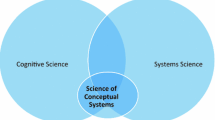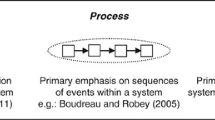Abstract
Conceptual models are a necessary component of strategic thinking as they provide a basis upon which to consider the implications of change in dynamic evolving systems. However, the thoroughness and robustness of the strategic thinking is often limited in utility if the conceptual models are poorly constructed. Here we describe a problem structuring approach for constructing and measuring conceptual models that overcomes such limitations. This approach defines a basic construct for a concept. Detailed concepts are then defined using this in conjunction with aspects of Checkland's Soft System Methodology. Importantly it allows determination of the relevant context for such concepts. In addition, a set of high-level metrics is defined so as to provide a mechanism for evaluating the ‘goodness’ of a conceptual model, particularly in terms of maturity and particularity.


Similar content being viewed by others
References
Checkland P (1981). Systems Thinking, Systems Practice. John Wiley & Sons: Chichester.
Checkland P (1985). Achieving ‘desirable and feasible’ change: an application of soft systems methodology. J Opl Res Soc 36: 821–831.
Checkland P (1989a). An application of soft systems methodology. In: Rosenhead J (ed). Rational Analysis for a Problematic World. John Wiley & Sons, Chichester, pp 101–119.
Checkland P (1989b). Soft systems methodology. In: Rosenhead J (ed). Rational Analysis for a Problematic World. John Wiley & Sons, Chichester, pp 71–100.
Coyle G (1997). The nature and value of futures studies or do futures have a future? Futures 29: 77–93.
Dortmans PJ and Curtis NJ (2002). Linking scientific and technological innovation with warfighting concepts: how to identify and develop the right technologies to win the future land battle. In: Quinn S (ed). Land Warfare Conference—Future Wars: Futuristic Forces. DSTO, Adelaide, Australia, pp 59–72.
Forder RA (2004). Operational research in the UK Ministry of Defence: an overview. J Opl Res Soc 55: 319–332.
Mingers J and Rosenhead J (2004). Problem structuring methods in action. Eur J Opns Res 152: 530–554.
Rosenhead J (1996). What's the problem? An introduction to problem structuring methods. Interfaces 26 (6): 117–131.
Willis P, Dortmans P, Curtis N and Tri N (2003). Army's concept framework—exploiting concepts as agents for change for Land Force development. In: Kelly J (ed). Land Warfare Conference. DSTO, Adelaide, Australia, pp 707–718.
Author information
Authors and Affiliations
Corresponding author
Rights and permissions
About this article
Cite this article
Dortmans, P., Curtis, N. & Tri, N. An analytical approach for constructing and measuring concepts. J Oper Res Soc 57, 885–891 (2006). https://doi.org/10.1057/palgrave.jors.2602059
Received:
Accepted:
Published:
Issue Date:
DOI: https://doi.org/10.1057/palgrave.jors.2602059




